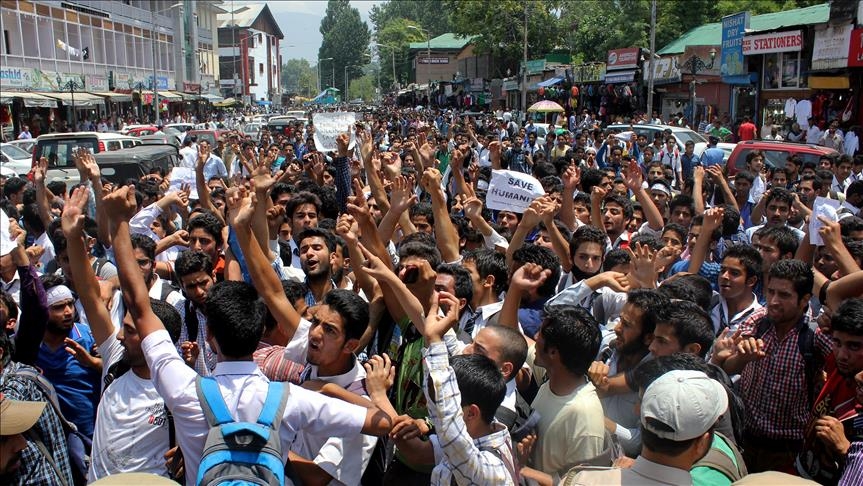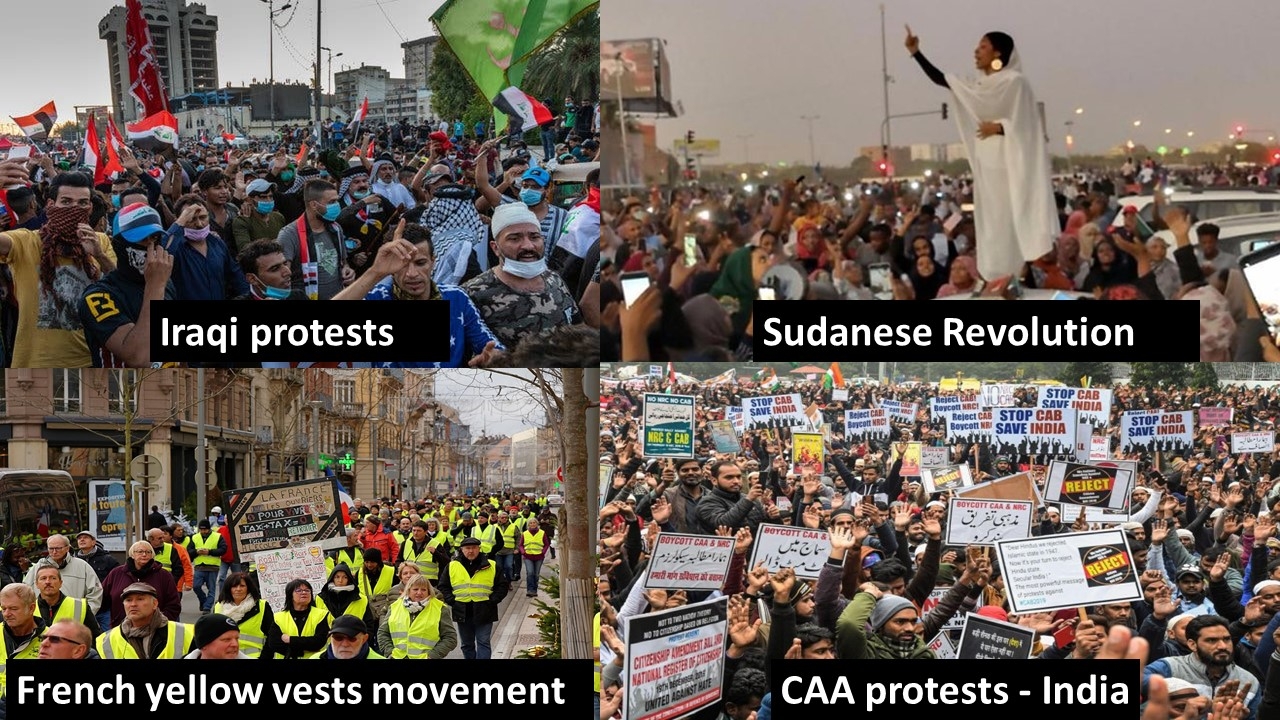Waves of Protests 24x365: Nature and Fallout
Total Views |
Surge of protests, mostly peaceful, but frequently turning violent nowadays, are engulfing modern India. As a result, the churning of the crucible of democracy namely – society, economy and politics – is most vicious and hell bent upon traversing on a self destructive course.

At international level, experts have classified the sweep of protests as the “Global Protest Wave of 2019” what with the abnormally large number of high profile protests world over.
List of protests in 2019 include: Sudanese Revolution, Algerian protests, the Egyptian protests, the Iraqi protests, the Iran protests, the Syria protests, Indonesian protests, Papua protests, Kazakhstan protests, the French yellow vests movement started in October 2018 and ongoing as of 2020, Catalan protests that started on October 14, 2019 in Barcelona in Spain; the Sardines movement (Italian: movement delle sardine) in Italy in November 2019, the 2019 Maltese protests started on November 20, 2019; starting from July 2019 numerous approved and unapproved rallies in Moscow, and Latin American Spring and 2019 Latin American protests and so on.
In retrospect, protests are all over to include: families, clans, castes, communities, educational institutions, hospitals, judiciary, farmers, workers, government employees, religious places of worship and, most importantly, inside and outside the Parliament and State Assemblies.
And, the triggers vary from situation to situation. Slogans like “Azadi, Save Citizenship, Save Constitution, Save Democracy etc.,” are used to incite, instigate and provoke protests. However, the root cause can be traced and linked to dissatisfaction and denial of what one may consider denial of freedom and opportunity. They offer opportunities for opposition political leaders and parties to exploit to regain relevance and power.
After all, there is too much “Azadi” on grand display. One can get away with abusing the Prime Minister, vandalize public and private properties (contra good Citizen), burn the Constitution and murder democracy. Defaced, mutilated and destroyed are the “Four Pillars of the Constitution” over the past 72-years. In the name of democracy, neo-dynasties have taken over the reins of modern India. Everyone is aware that free and fair elections are the worst fraud on “We the People” of India.

Let me define the typology of protests commonly sensationalized in the media include: acrimonious media debates; lawsuits; rallies or demonstrations; fast unto death; self-immolation; candle light vigils; picket; boycott; civil disobedience; rail and rasta rokos; strikes, slow down and lockouts; street plays/songs; motorcades; information distribution; attacks by instigators, melees, mob violence and vandalism; and the “Stone Pelting” against the law and order machinery.
The latest wave of protests making media headlines 24x365 are against the Citizenship Amendment Act that started in December 2019, which was passed by the parliament on December 11 and the proposed enactment of the National Register of Citizens. The protests by student organizations have been incited, instigated and supported by various political parties, human rights groups and civil society groups. JNU Student protests are over incidents of police brutality and misconduct on the campus and outside of Jamia Millia Islamia and the free for all clashes inside the JNU.
Add to them, others to include: Anti-Hindi protests in Tamil Nadu and Karnataka, Amravati capital protests in Andhra Pradesh, Doctors protests, Aarey protests, Assam protests, West Bengal protests, and so on.
Undeniably, protest movements world over are influencing protestors in India, to adopt various means, including stone pelting, to vent frustrations on various issues. Rumors, fake, fraud and paid coverage over visual media channels is quite common.
Political leaders and parties have become experts in exploiting such events by provoking, inciting and actively abetting their explosion into violence and anarchy.
Mobilization of crowds and mobs for the protests today has gone commercial. Political parties and organizers usually pay Rs. 500-700 per day plus Biriyani, snacks and tea for each individual including free bus ride to the place of protest. Even a group of 50-100 people can successfully undertake Rasta and Rail Roko protests.
And, the foreign funded paid partisan visual media with utter disregard to unity and integrity of India combined with online social media due to explosion of access to information and "a rising generation of discontented youth with ever growing aspirations” have become a deadly combination.
In the name freedom of speech and expression to dissent, youth have mastered their deadly combination to fuel violent protests and anarchy. Its fallout is simple: rapidly changing balance of power between government and society in both democratic and authoritarian states.
Ironic but true, political parties have converted over the past 72-years educational campuses into breeding grounds for protests in India and grooming future leaders. Ipso facto, student union politics, sponsored by rival political parties, provide a platform for their rise to prominence ultimately on the political scenario. It is the easy path to power, wealth and prosperity. No academic excellence or merit is vital. Mobilization power of sectarian groups is the only pre-requisite.
Nowadays, student protests, some starting as flash protests, are reported frequently from quite a few universities – Central and State funded – over administrative and academic issues. For example, violent conflicts in JNU can be traced to 1980s when teachers and students clashed over plans to change the admission policy resulting in "anarchy" on the campus. Students attacked homes of teachers. In reaction, police thrashed students and arrested many students; and nearly 40 of them expelled from the campus.
Today, the JAMIA and the AMU have joined the JNU in staging violent protests both inside and outside the campuses. “Azadi” is their war cry what with the concept least understood by protestors. Surely “Azadi” does not imply disruption and destruction of public and private properties. Certainly, it does not imply economic paralysis adversely impacting the daily wage earners and traders.
Blame game is its natural fallout what with the students blaming the rigidity of the university hierarchy and the government besides the police for the violence and vice versa. Also, for labeling dissenters speeches as "anti-national"; and called "urban" Maoists – Tukde Tukde Gang - and charging them under “Sedition”.
Views of critics of anti-Modi and BJP include: systematic manufacturing of atmosphere of suspicion and hatred; growing intolerance for dissenting ideological views; muzzling and crushing dissenters on the campus by brute force; and the JNU as a hotbed of left-wing politics.
And, the critics are quick to blame the high handedness of the government machinery invoking the dictum that the right to protest is a human right arising out of a number of recognized human rights - right to freedom of assembly, the right to freedom of association, and the right to freedom of speech.
However, the critics, mostly intellectuals per se, forget that there are many international treaties spelling out clear articulations of the right to protest. So, it is crucial for individuals who are interested in protesting to stay up to date and aware of specific prohibitions like "propaganda of war" and advocacy of "national, racial or religious hatred". Also, the restriction of the freedom to assembly if it is necessary "in a democratic society in the interests of national security or public safety, public order, the protection of public health or morals or the protection of the rights and freedoms of others, can be imposed."
Dissent is certainly citizen’s birth right in democracy; but not for driving wedge between the community, besides spreading violence and anarchy.
In retrospect, in a civilized society “Freedoms” must be exercised with Responsibilities”. So, maintaining peace while protesting is obligatory. No human rights instrument or national constitution grants the absolute right to protestors to indulge in “Stone Throwing” against police forces and wanton destruction of public and private properties besides spreading anarchy and violating the freedoms of others.
Critics must realize that protesting in democracy need not necessarily end up in civil disobedience or riots paralyzing society and governance by violating the laws of the state. At the same time in times of crises consequent to widespread tension or controversy within a society, it is important for government institutions to preserve its citizen's right to protest peacefully.
In sum, the triggers may be any. Economic issues, such as corruption, unemployment, economic inequality and poverty alleviation besides the desire for political freedom from governmental political repression are the triggers. In reality the real underlying cause is vicious politics seeking to exploit every single opportunity arising out of unemployment and economic travails of common people by promising the ‘moon’ to the gullible people.
Tremendous uncertainty stares starkly over the youth. Not only students but also farmers and workers have been protesting in the past. In fact, the entire spectrum of society undergoing the twin wave of “growing awakening and rising aspirations” are disillusioned and disappointed against the rulers for not providing their rightful, fair and just share in the economic pie.
Consequently, there is cumulatively piling up lack of trust in the political elite fuelling feeling of crisis of authority due to non fulfillment of wide variety of grievances. And, round the clock elections provide a platform for sustained protest movements, continuing even after their initial grievances have been met due to vicious politics in pursuit of power. If embers of one protest are doused, yet another one springs up elsewhere due to political party’s penchant to create crises. Such are the grim prospects in posterity.
Sure course for self destruction and disintegration of modern India!



